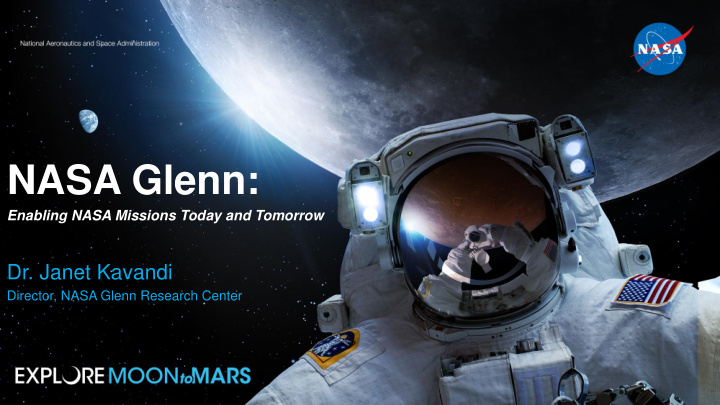



NASA Glenn: Enabling NASA Missions Today and Tomorrow Dr. Janet Kavandi Director, NASA Glenn Research Center
NASA OVERVIEW VISION To discover and expand knowledge for the benefit of humanity. MISSION Lead an innovative and sustainable program of exploration with commercial and international partners to enable human expansion across the solar system and bring new knowledge and opportunities back to Earth. Support growth of the Nation’s economy in space and aeronautics, increase understanding of the universe and our place in it, work with industry to improve America’s aerospace technologies, and advance American leadership.
NASA OVERVIEW Deep Space Network Facilities Goldstone, in California, Mojave Desert Glenn Research Center Near Madrid, Spain Near Canberra, Australia Kathrine Johnson Independent Verification & Validation Facility Fairmont, WV Mountain View, CA Greenbelt, MD Lewis Field (Cleveland) Washington, DC • 350 acres • 1,534 civil servants, 1,611 contractors Wallops Flight Facility Wallops Island, VA Edwards, CA Hampton, VA Huntsville, AL Jet t Prop ropulsion sion Laborato ratory ry Pasadena, CA Stennis Space Center, MS White Sands Test Facility Houston, Texas Plum Brook Station (Sandusky) White Sands, NM Cape Canaveral, FL Michoud Assembly Facility • 6500 acres New Orleans, LA 24 civil servants, 105 contractors •
5
WHY THE MOON? The Moon is a scientific treasure-trove and a proving ground for exploration Our sustainable exploration approach is reusable and repeatable Over the next decade, we will build an open, sustainable exploration architecture on and around the Moon, with capabilities for future missions to Mars WHAT IS ARTEMIS? Artemis was the twin sister of Apollo and goddess of the Moon Artemis personifies NASA’s path to the Moon, returning the first woman and next man to the lunar surface by 2024. With the horizon goal of sending humans to Mars, Artemis begins the next era of exploration. 6
7
LOW-EARTH ORBIT The ISS is a crucial stepping stone to deep space. The only microgravity laboratory in which long-duration testing of critical spaceflight systems. Key ISS research conducted at NASA Glenn: • Fluid physics • Combustion and fire safety • Human performance and exercise countermeasures NASA will grow a robust commercial space industry with constant human presence in Earth orbit. 8
ORION SPACECRAFT Orion was designed to meet the evolving needs of our nation’s exploration goals as it will carry and sustain crew on deep space missions. It features dozens of cutting-edge technology advancements and innovations. It will launch from NASA’s modern spaceport at Kennedy Space Center on the powerful heavy-lift SLS rocket. Upcoming Artemis missions with Orion in support of 2024: • Artemis 1 : Un-crewed flight test around the Moon in 2020 • Artemis 2 : First crewed flight to the Moon in 2022 • Artemis 3 : First crew to the lunar surface in 2024 9
10
GATEWAY Our mobile command and service module for human and robotic exploration on and around the Moon. Two phased approach for building Gateway: • Phase 1: focused on critical requirements to support 2024 human landing • Phase 2: larger Gateway for a long-term, sustainable presence A strategic outpost around the Moon – U.S. in leadership role with multiple international partners joining Phase 2 efforts. Gateway is the building block of future exploration technologies and capabilities, before we travel to Mars. 11
Power and Propulsion Element Glenn leads the public-private partnership for the demonstration of the Gateway’s power and propulsion element, along with commercial partner Maxar Technologies. It is a high-power, 50-kilowatt Solar Electric Propulsion spacecraft – operating at ~3x current capabilities. It will also provide power and communications for the Gateway. NASA is targeting launch on a commercial rocket in late 2022.
SURFACE POWER Kilopower will demonstrate safe, abundant, and reliable nuclear power for human lunar exploration. It is a 1-kWe reactor prototype with technology that is relevant for systems up to 10 kWe. Kilopower was successfully demonstrated in 2018 at the Nevada National Security Site. 14
15
SUPERSONIC COMMERCIAL FLIGHT The X-59 QueSST – NASA’s first “X - plane” in decades. The uniquely shaped X-59 includes technologies that will reduce a sonic boom to a gentle thump. Reducing the boom will allow regulators to change the rules, enabling future overland commercial supersonic flight. NASA Glenn’s 8 -foot by 6- foot Supersonic Wind Tunnel recently completed a test on the X-59 model. The tests successfully demonstrated the aircraft should perform as expected during initial flight tests in the early 2020s. 16
ELECTRIC AIRCRAFT PROPULSION NASA is working to enable a paradigm shift from gas to electrified aircraft propulsion for commercial aviation. Goal: to transform commercial aviation via advanced propulsion technologies that meet aircraft-level requirements for energy use, emissions and noise. NASA believes electrified propulsion, along with other technological advances in the space, will: Reduce energy usage by <60% Reduce emissions by <90% Reduce noise pollution by ~65% NASA Glenn is critical to advancing aircraft power and hybrid-election propulsion systems. 17
18
ENGINE AND AIRCRAFT ICING NASA Glenn is an international research leader in airframe and engine icing. Most current aircraft icing protection technologies were largely developed at Glenn. Provide research and information on the effects of icing conditions to the FAA via ground-based testing, software tools and flight evaluations. Glenn houses world-class test facilities used to create icing conditions for models, wing sections and engines, as well as utilizing flying laboratories. Engaging with industry and academia on new, developmental technologies, like icephobic materials. 19
ADVANCED MATERIALS Shape Memory Alloys are materials that can be deformed and recover their original shape upon heating. NASA Glenn has been working to develop new materials that can operate up to ~300 ° C, compared to ~80 ° C on commercially available alloys. Investigating uses in both aero and space applications like: aircraft wing components and rover tires. SMAs provide numerous benefits: • Opens up possibilities for small, lighter actuators • Eliminates large systems requirements (hydraulic, pneumatic, etc.) and the need for sensors and electronics • Low maintenance because of simple, frictionless designs 20
ADVANCED MATERIALS 21
Recommend
More recommend